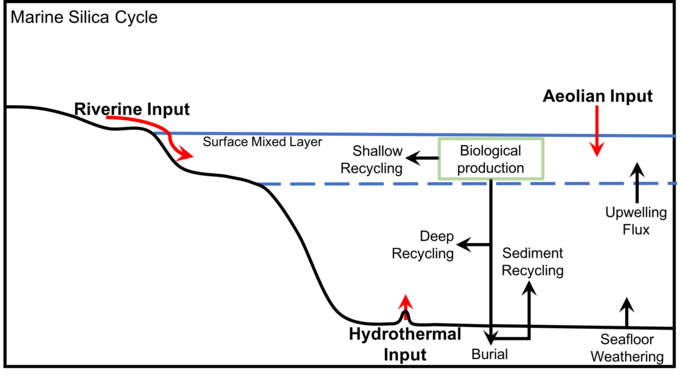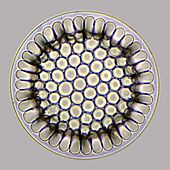Silica cycle facts for kids
The silica cycle is like a big journey that silicon takes around our planet. Silicon is a very common element on Earth, and it's super important for life. This cycle helps move silicon between rocks, soil, water, and living things. It also works closely with the carbon cycle, which is important for controlling the Earth's climate.
Contents
What is the Silica Cycle?
Silicon is the second most common element in the Earth's outer layer, called the crust. Only oxygen is more common! When rainwater, which has some carbon dioxide in it, falls on rocks, it slowly breaks them down. This process is called weathering. Weathering creates a special liquid form of silicon called silicic acid. This silicic acid then travels into rivers and oceans.
Silicifiers are tiny living things that use silicic acid to build their bodies. They create hard, tiny structures made of biogenic silica, which is also called opal. Think of it like building blocks! Many of these silicifiers are very important in the ocean.
Some examples of these tiny builders are:
- Diatoms: These are like tiny plants in the ocean. They use silicon, along with other nutrients, to grow. They also help take carbon dioxide out of the air and store it in the ocean.
- Rhizarians, silicoflagellates, and choanoflagellates: These are other small organisms that build with silica.
- Siliceous sponges: These are larger animals that also use silica for their skeletons.
Diatoms are especially important in the ocean. When they die, they sink to the deep ocean, taking the carbon they absorbed with them. This helps store carbon away for a long time. Studying these tiny silica structures helps scientists learn about Earth's climate and oceans from long ago.
Silicon on Land
Silicon is also a key nutrient for plants, trees, and grasses on land. Rivers carry silicon, and it can settle in the soil. Plants can easily take up silicon to make tiny, strong structures called phytoliths.
Phytoliths help plants stand up straight and protect them from animals that might want to eat them. Animals find it hard to digest plants that are rich in silica! When plants break down, they release silicon back into the soil. This happens even faster than rocks weathering.
How Rocks Break Down (Weathering)
Silicate minerals are found in almost all rocks on Earth. They make up about 90% of the Earth's crust! The main way silicon gets into the soil is through weathering. How fast rocks weather depends on things like rainfall, how much water runs off, the types of plants growing, and the shape of the land.
Even very strong rocks like quartz can dissolve over time when rainwater hits them. The water slowly breaks the bonds between the atoms in the rock.
When quartz dissolves, it forms silicic acid:
- SiO
2 + 2H
2O → H
4SiO
4
Silicon's Journey to the Ocean (Sinks)
The biggest way silicon leaves the land is by being carried to the ocean by rivers. Silicon stored in plants or dissolved in water can flow into the sea. About 6 units of silicon (Tmol Si yr−1) are carried this way each year. This is the main way silicon gets from land to the ocean. A small amount of silicon also gets buried in land sediments and becomes part of the Earth's crust.
Silicon in the Ocean
Tiny creatures in the ocean, like diatoms and radiolaria, are the main users of dissolved silicic acid. They turn it into hard silica shells. Most of the silicon in the ocean is recycled very quickly. Only a small amount (about 3%) gets buried in the seafloor each year. This means silicon is used over and over again in the ocean!
The silicon in the ocean's living parts stays there for about 400 years. This fast recycling happens because silica shells dissolve in the water, and then new organisms use that silicon again.
Where Ocean Silicon Comes From (Sources)
The main ways silicon enters the ocean are:
- Rivers: Rivers bring the most silicon to the ocean, making up about 90% of all the silicon that enters the sea.
- Wind (Aeolian dust): Wind can carry tiny dust particles from land into the ocean. These particles can release silicon when they dissolve in seawater.
- Sandy Beaches: Recent studies suggest that waves on sandy beaches can dissolve sand grains, releasing a lot of silicon into the ocean. This might be a much bigger source than we thought!
- Groundwater: Water flowing underground can also carry silicon into the ocean.
- Seafloor Weathering and Hydrothermal Vents: Rocks on the seafloor can also break down, and hot vents on the ocean floor can release silicon.
Where Ocean Silicon Goes (Sinks)
Most of the silica shells made by ocean creatures dissolve quickly in the upper ocean. This turns them back into silicic acid, ready to be used again. The rest of the silica sinks to the deep ocean. Even there, much of it dissolves before it reaches the seafloor. Over 90% of this deep-ocean silica is recycled and brought back up to the surface to be used again.
The biggest long-term storage place for silicon in the ocean is the deep seafloor. Here, silica forms a muddy layer called siliceous ooze. If this ooze builds up faster than it dissolves, it gets buried. Over millions of years, this buried ooze can turn into a hard rock called chert. Chert permanently removes silicon from the ocean cycle.
Eventually, this chert can get pushed deep under the Earth's crust. There, it changes into other minerals and can later be brought back to the surface by geological processes. Once at the surface, it can start the weathering process again! Silicon can also be stored along the edges of continents, often in the form of siliceous sponges.
How Humans Affect the Silica Cycle
Over the last 400 years, more farming has exposed more rocks and soil. This has sped up the rate at which rocks weather, sending more dissolved silicon into rivers. However, building more dams has reduced the amount of silicon reaching the ocean. This is because tiny freshwater diatoms behind the dams use up the silicon.
Also, pollution from nitrogen and phosphorus can cause other types of tiny ocean plants (that don't use silicon) to grow more. Warmer ocean waters can also make silica dissolve faster. These changes might mean less silicon gets stored in ocean sediments in the future.
Scientists also think that ocean acidification (when the ocean becomes more acidic) might be making it harder for diatoms in the Southern Ocean to build their silica shells.
Silicon's Role in Climate
The silica cycle is very important for controlling Earth's climate over long periods. It works closely with the global carbon cycle. When silicate rocks weather, they take carbon dioxide from the air. This process helps balance the amount of carbon dioxide in the atmosphere. For example, when there's a lot of volcanic activity releasing CO2, increased rock weathering can help remove it. This balance helps control the greenhouse effect and the ocean's acidity over millions of years.
The silica shells buried on the seafloor tell us a lot about how productive the ocean was in the past. They can help scientists understand big changes in ocean currents and past climates. Silicon stays in the ocean for about 10,000 to 15,000 years. Because this time is relatively short, ocean silicon levels are sensitive to changes between glacial (ice age) and interglacial (warmer) periods. This makes silicon a great way to study past climate changes.
Scientists can also study different types of silicon atoms (called isotopes) found in these ancient silica shells. This helps them learn about past climate and how nutrients moved around. This is especially useful in places like the Southern Ocean, where other types of ancient shells are not well preserved.
See also
- Carbon cycle
- Oxygen cycle
- Silicification






